Ye Pleasant Mount: 1989 1990 Excavations - Open site which ...
Ye Pleasant Mount: 1989 1990 Excavations - Open site which ...
Ye Pleasant Mount: 1989 1990 Excavations - Open site which ...
You also want an ePaper? Increase the reach of your titles
YUMPU automatically turns print PDFs into web optimized ePapers that Google loves.
x 28 cm north-south and it was 19 cm in depth. The feature fill consisted ofbrown sandy<br />
loam and brown sandy clay. It contained a small quantity of Indian and Euro-American<br />
artifacts. This feature overlays feature 14.<br />
Feature 13. Feature 13 was an elongated oval stain that intruded into an earlier feature<br />
(Feature 14). The feature measured 56 cm northeast-southwest x 46 cm northwestsoutheast.<br />
This pit contained a variety ofEuro-American artifacts including several straight<br />
pins and small lead shot. Several of the artifacts from Test Unit 12, Level 3 also may be<br />
associated with this feature. The feature fill consisted ofbrown sand.<br />
Feature 14. Feature 14 was a linear trench feature that extended diagonally through Test<br />
Units 12, 13, and 14 at a bearing of295 degrees west-northwest. The feature measured 60<br />
cm x 2.8 meters. It was basin-shaped in profile. The feature ranged in depth from 67 to<br />
120 cm below datum. The feature fill consisted of brown and yellowish brown sand.<br />
Indian and Euro-American artifacts were recovered from the feature. This feature is<br />
interpreted as section of a pallisade ditch that surrounded the <strong>Mount</strong> <strong>Pleasant</strong> Fort. The<br />
construction of this feature predated Features 12 and 13.<br />
Feature 15. Feature 15 was an oval pit located in Test Unit 20. It was first recognized<br />
during the excavation of Level 2. The feature measured approximately 78 cm northeastsouthwest<br />
x 76 cm northwest-southeast, and it was 80 cm in depth. The feature fill<br />
con<strong>site</strong>d of yellowish brown sand and bricks. Indian and Euro-American artifacts were<br />
recovered from the feature. The concentration of bricks in the feature suggests an<br />
architectural function, although the alignment ofbricks within the feature appeared random.<br />
These bricks may have supported a post.<br />
Feature 16. Feature 16 was an irregular-shaped stain located in Test Units 17 and 18 at<br />
the base of Level 3. It measured 108 cm north-south x 49 cm east west, and it had a<br />
maximum depth of 56 cm. The feature fill consisted of yellowish brown sand. It may<br />
have been two overlapping features. Indian an4 Euro-American artifacts were recovered<br />
from the feature. Although the feature extended to a depth of 122 cm below datum, Euro<br />
American artifacts were not found below 90 cm.<br />
Feature 17. Feature 17 was a round stain that was either a natural tree disturbance or a<br />
post that had been disturbed by a tree root. It measured 15 em in diameter and was 36 cm<br />
in depth. The feature fill consisted of dark brown sand and charcoal. It contained one<br />
aboriginal artifact.<br />
93










